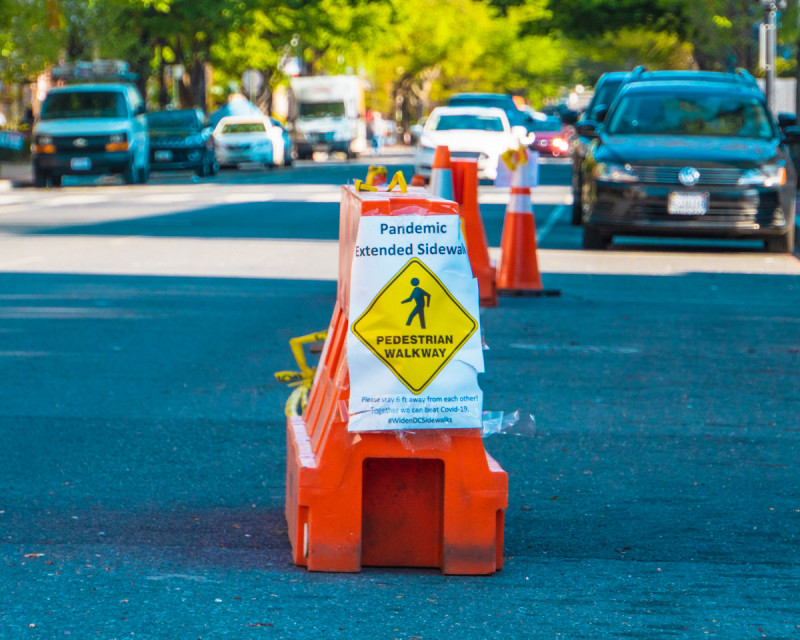DC will temporarily widen some sidewalks near grocery stores and other businesses

An unofficial "pandemic extended sidewalk" in Dupont Circle. DC will create similar official versions in select areas. Image by Ted Eytan licensed under Creative Commons.
To help people practice social distancing and stay six feet apart, DC will expand some sidewalks in wards throughout the District near essential businesses such as grocery stores, Mayor Muriel Bowser announced Monday.
Most locations have not been announced yet, but the idea is to provide people on foot more space when lining up to get into essential stores like pharmacies, groceries, hardware stores, and so forth. The District Department of Transportation will take nominations from Business Improvement Districts or Advisory Neighborhood Commissions, and Bowser said they will appear in all eight wards of DC.
My local hardware store, for instance, has employees serving customers by standing behind a folding table in front of the shop door. People line up and, one by one, tell the store employee what they’d like; that person then goes to get it inside. There are taped-off lines showing how far back people waiting should stand.
That hardware store happens to have a very wide sidewalk and so might not need this, but there have been reports and pictures of people lining up in tight quarters outside other stores.
Jordan Pascale reported that the first such zone will go on Connecticut Avenue in Cleveland Park, where a parking “service lane” cuts into an otherwise wide sidewalk, leaving very little space to walk. Some residents have suggested closing it in the past, though without success; the group Cleveland Park In the City proposed closing it now, given the need for social distancing and lower parking demand, and Councilmember Mary Cheh (Ward 3) supported the concept.
Image by @CPITC used with permission.
This move responds to growing calls for more space to walk
Advocates have been encouraging area officials to repurpose more street space for other uses such as pedestrian safety, running or cycling for exercise, or children’s play. The streets are mostly empty, yet sidewalks are often too narrow for people to safely pass with six feet of space. Meanwhile, the empty streets have led to speeding and, occasionally, even drag racing.
They have pointed out that people often simply lacked the physical space to comply with the mayor’s order (and similar ones from many governors including in Maryland and Virginia), particularly in walkable urban places. As Caitlin Rogger previously wrote for GGWash,
Whether people actually stay at home, as directed in the District, Maryland and Virginia, will depend on a well established public health concept, public acceptance. It’s what it sounds like: people have to be willing to actually follow a public health rule or it won’t work.
We don’t only need to stay at home; we need to stay at home for many weeks and probably multiple months. As the stay-at-home orders drag on, policymakers will feel pressure to release the orders. But the US doesn’t have a good model yet for when it’s OK for people to go back to mixing socially, so it makes sense to err on the side of caution and extend, rather than limit, the period of distancing beyond what the models suggest. We don’t live in an authoritarian state, where the police or military can easily force people not to leave their homes. So we need to make this work well for it to work at all.
While Mayor Bowser has been reluctant to embrace some of these measures which we first saw in New York, Philadelphia, and Bogotá. Oakland, California, jumped to be a leader among US cities by dedicating 74 miles of “slow streets” for people to go outdoors, allowing car traffic only for locally necessary activites like picking up and dropping off.
Bowser did work out an agreement with the National Park Service to close Beach Drive, in Rock Creek Park; Anacostia Park; and Fort Davis Drive in Fort Dupont Park to cars, creating more space for exercise. Montgomery County has similarly closed Little Falls Parkway, and previously did the same for Sligo Creek Parkway. DC, Montgomery County, and Alexandria all created no-parking zones for drivers to pick up deliveries from restaurants.
Meanwhile, some activists calling themselves the “DC Department of Transformation” have been placing their own cones at various spots around the District. With this project, in select spots, that kind of intervention could become official.
Update, April 21: This post has been expanded with information about the proposed closure in Cleveland Park.
